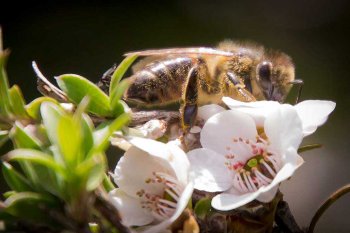
The bacterial pathogen American FoulBrood (AFB) is the single largest disease of honey bees in New Zealand. The pathogen is spread through spores, which once ingested by young bee larvae, rapidly multiply and kill by breaking down the larvae’s body.
The infectious nature of the pathogen means that once the signs are recognised in a New Zealand hive, it must be destroyed within seven days.
The Ministry of Primary Industries reported colony loss related to the pathogen in an average of 3.95 percent of winter colony losses across the country in 2016-17, with one large commercial beekeeper losing 200 colonies in the central North Island.
Massey’s Hendrickson Lab has teamed up with the American Foulbrood Management Agency for a successful bid of more than $275,000 from the Ministry for Primary Industries’ Sustainable Farming Fund (SFF) to look into a natural bio-protective agent that may be key to keeping the pathogen at bay. The research will focus on developing cocktails of native New Zealand bacteriophages, which are simple viruses that can infect the harmful pathogen and destroy it from within.
Chief Scientist Dr Heather Hendrickson says maintaining healthy hives is critical to safeguarding the agricultural and horticultural sectors, with honey bees providing pollination for much of the food New Zealand consumes. “Our work is not focused on providing a ‘cure’ for infected hives, but as a measure to prevent infection in a hive before it takes hold.
“My lab has been working with bacteriophages for a number of years and we have been discovering more and more about the power of these simple and abundant viruses. Previous work abroad indicates that New Zealand AFB pathogens are susceptible to destruction by a set of specific bacteriophages already present already in New Zealand soils that can destroy the infectious strains.”
To confirm this, the team will be undertaking large scale screening of soils and engaging with the beekeeping community to acquire samples from hives.
“The ideal bacteriophages are hypothesised to be most abundant in the soil beneath healthy hives so obtaining these samples from beekeepers is crucial to unlocking the secret to these hives’ success. The neat thing from a citizen science perspective is that if we find a bacteriophage in their soil samples, the beekeepers get to name a bacteriophage.”
An anaerobic chamber donated from the University of Otago will allow the team to screen for the bacteriophages and once isolated, they will be sequenced to determine if they are safe for use and can be combined to produce a bio-protective phage cocktail for field testing.
Sustainable method
Dr Hendrickson says the key thing for the project is the sustainability of bacteriophages as opposed to other methods. “Bacteriophages will have no effect on other bacteria in the environment. They are a natural, native, biodegradable alternative to chemical or drug-based measures which leave unwanted residues, unlike antibiotic treatments which are already banned by the industry because of the residue they leave in the honey. Once the pathogen is cleared, these viruses are naturally recycled over time.
“Bacteriophages have many benefits over antibiotics, as they can be targeted to specific bacteria while the rest of the healthy microbial communities thrive. If the phages are successfully isolated, work could then be undertaken to develop a marketable, sustainable and inexpensive product for the beekeeping industry in New Zealand.”
The project, ABAtE: Active Bacteriophages for American Foulbrood Eradication, will start in July.
Source: Massey University



 Classifieds
Classifieds


